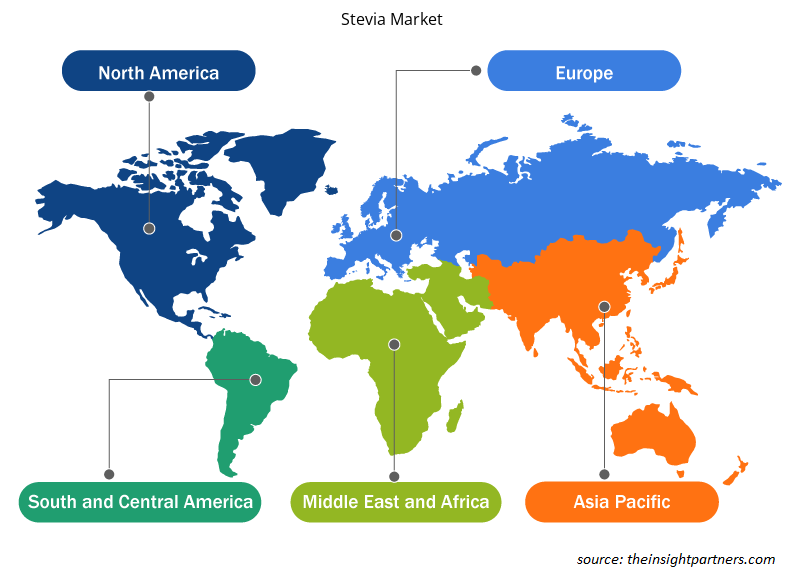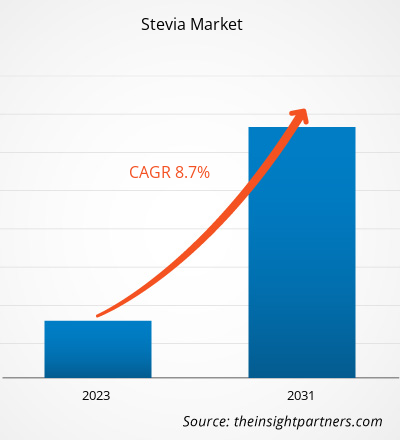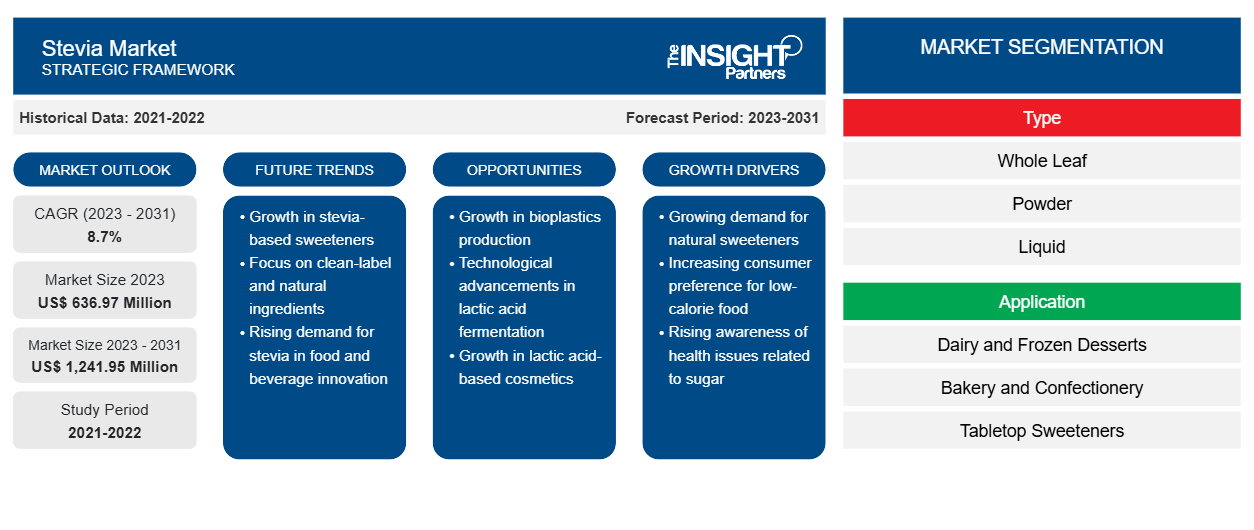Si prevede che la dimensione del mercato della stevia raggiungerà 1.241,95 milioni di dollari entro il 2031, rispetto ai 636,97 milioni di dollari del 2023. Si prevede che il mercato registrerà un CAGR dell'8,7% nel periodo 2023-2031. La tendenza crescente per le alternative allo zucchero ipocaloriche con una maggiore consapevolezza calorica rimarrà probabilmente la tendenza chiave nel mercato.
Analisi del mercato della stevia
La crescente consapevolezza di una dieta sana e la crescente consapevolezza della salute tra le persone sono i principali motori del mercato della stevia nel mondo. Paesi come Stati Uniti, Germania, Regno Unito, Canada, Cina, Giappone e Corea del Sud sono i principali contributori alla crescita del mercato nel mondo. I consumatori cercano etichette simili e ingredienti naturali man mano che diventano più consapevoli della propria alimentazione. Inoltre, la maggiore consapevolezza dell'obesità, del controllo del peso e dell'importanza di seguire una dieta sana sta aumentando la domanda di prodotti a base di stevia in tutto il mondo. Il mercato globale della stevia è in crescita grazie ai progressi nel settore alimentare e delle bevande. Il settore alimentare e delle bevande è il più grande settore manifatturiero nei paesi del mondo. Il crescente consumo di alimenti trasformati tra i consumatori dovuto allo stile di vita frenetico e alla praticità sta guidando la crescita del mercato della stevia.
Panoramica del mercato della stevia
La crescente inclinazione dei consumatori verso i dolcificanti naturali ha guidato la crescita del mercato globale della stevia. Con l'aumento dell'incidenza di diabete e obesità in tutto il mondo, i consumatori si stanno progressivamente spostando verso prodotti dolcificanti naturali. Secondo l'International Diabetes Foundation, 641 milioni di persone saranno affette da diabete entro il 2040, rispetto ai 415 milioni del 2015. L'obesità è una malattia diffusa che porta al diabete insieme ad altre malattie croniche come ipertensione, sindrome metabolica, rischio cardiovascolare e retinopatia. Le autorità di tutto il mondo si stanno concentrando su uno stile di vita più sano, che include una riduzione del numero di calorie consumate, in particolare zuccheri aggiunti. L'Organizzazione Mondiale della Sanità (OMS) ha raccomandato una riduzione degli zuccheri aggiunti nello stile di vita quotidiano. Per ridurre la quantità di zucchero assunto, i consumatori preferiscono dolcificanti naturali come la stevia, che aiuta nella gestione del peso riducendo gli zuccheri aggiunti e le calorie. Insieme a questo, in Europa, i consumatori stanno sempre più consumando prodotti senza zuccheri aggiunti. Secondo il sondaggio New Nutrition Business del 2020, due terzi dei consumatori europei stanno cercando di ridurre l'assunzione di zucchero a causa del crescente tasso di obesità e diabete, che ha portato a una maggiore domanda di stevia in Europa. Pertanto, un aumento dell'inclinazione dei consumatori verso i dolcificanti naturali sta guidando la crescita del mercato della stevia.
Personalizza questo report in base alle tue esigenze
Riceverai la personalizzazione gratuita di qualsiasi report, comprese parti di questo report, o analisi a livello nazionale, pacchetto dati Excel, oltre a usufruire di grandi offerte e sconti per start-up e università
-
Scopri le principali tendenze di mercato in questo rapporto.Questo campione GRATUITO includerà analisi di dati che spaziano dalle tendenze di mercato alle stime e alle previsioni.
Driver e opportunità del mercato della stevia
Crescenti preoccupazioni su diabete e obesità favoriscono il mercato
Con l'aumento dell'incidenza di diabete e obesità in tutto il mondo, i consumatori si stanno progressivamente orientando verso prodotti dolcificanti naturali. Secondo l'International Diabetes Foundation, 641 milioni di persone saranno affette da diabete entro il 2040, rispetto ai 415 milioni del 2015. L'obesità è una malattia diffusa che porta al diabete insieme ad altre malattie croniche come ipertensione, sindrome metabolica, rischio cardiovascolare e retinopatia. Le autorità di tutto il mondo si stanno concentrando su uno stile di vita più sano, che include una riduzione del numero di calorie consumate, in particolare zuccheri aggiunti. L'Organizzazione Mondiale della Sanità (OMS) ha raccomandato una riduzione degli zuccheri aggiunti nello stile di vita quotidiano. Per ridurre la quantità di zucchero assunto, i consumatori preferiscono dolcificanti naturali come la stevia, che aiuta nella gestione del peso riducendo gli zuccheri aggiunti e le calorie. Insieme a questo, in Europa, i consumatori stanno sempre più consumando prodotti senza zuccheri aggiunti. Secondo il sondaggio New Nutrition Business del 2020, due terzi dei consumatori europei stanno cercando di ridurre l'assunzione di zucchero a causa del crescente tasso di obesità e diabete, che ha portato a una maggiore domanda di stevia in Europa. Pertanto, un aumento dell'inclinazione dei consumatori verso i dolcificanti naturali sta guidando la crescita del mercato della stevia
Crescente domanda di dolcificanti ipocalorici in alimenti e bevande
Le aziende stanno diventando più consapevoli della stevia; Pepsi e Coca-Cola, ad esempio, hanno iniziato a usare la stevia nelle loro bevande analcoliche come dolcificante. La stevia è usata anche da altri produttori di prodotti alimentari e bevande come yogurt, caramelle e cibi lavorati come il ketchup. Le opportunità sul mercato sono aumentate anche dagli sviluppi nell'etichettatura della stevia. Il nuovo aggiornamento dell'etichettatura UE, che cambia il nome del prodotto da "Glicosidi steviolici (E 960)" a "Glicosidi steviolici da stevia (E 960)", offre ai consumatori ulteriore trasparenza e informazioni sull'origine botanica del prodotto. Si prevede che la domanda dei consumatori sarà influenzata dal cambiamento. Secondo l'Ingredient Tracker di Cargill, solo circa il 25% dei consumatori europei conosce la frase "glicosidi steviolici", mentre il 64% ha familiarità con "stevia". Tuttavia, poiché i consumatori prestano maggiore attenzione agli ingredienti utilizzati negli alimenti e nelle bevande trasformati, si prevede che la consapevolezza del termine "glicosidi steviolici" aumenterà nel tempo, il che dovrebbe aprire nuove opportunità nei prossimi anni.
Analisi della segmentazione del rapporto di mercato Stevia
I segmenti chiave che hanno contribuito alla derivazione dell'analisi del mercato della stevia sono il tipo e l'applicazione
- In base al tipo, il mercato della stevia è suddiviso in foglia intera, polvere e liquido. Il segmento della polvere ha detenuto la quota di mercato maggiore nel 2023. Una polvere bianca di stevia è un sostituto naturale e sano dello zucchero. Le foglie di stevia vengono essiccate per formare la polvere e la forma in polvere di stevia è carica di estratti di foglie di stevia ed eritritolo
- In termini di applicazione, il mercato è segmentato in latticini e dessert surgelati, prodotti da forno e dolciumi, dolcificanti da tavola, bevande e altri. Il segmento dei latticini e dei dessert surgelati ha detenuto una quota significativa del mercato nel 2023. La crescente domanda di dolcificanti ipocalorici in gelati, yogurt, frullati e altri prodotti lattiero-caseari dovuta alla crescente consapevolezza calorica e alla crescente preferenza per prodotti con affermazioni "senza zuccheri aggiunti" dovrebbe guidare la domanda di stevia nei latticini e nei dessert surgelati, stimolando la crescita del segmento.
Analisi della quota di mercato della stevia per area geografica
L'ambito geografico del rapporto sul mercato della stevia è suddiviso principalmente in cinque regioni: Nord America, Asia Pacifico, Europa, Medio Oriente e Africa, Sud e Centro America.
L'Asia Pacifica ha dominato il mercato. Nella regione Asia Pacifica, consumatori, esperti di salute e governi sono diventati più attenti alla salute e alla dieta. Ciò ha portato all'adozione di dolcificanti naturali, tra cui la stevia, da parte di vari produttori di alimenti e bevande. La stevia è un dolcificante di origine vegetale che funziona bene in varie applicazioni di alimenti e bevande. Con la crescente importanza del dolcificante stevia, il suo utilizzo è aumentato anche in bevande analcoliche gassate, gelati, prodotti da forno, acque aromatizzate e frizzanti, tè e caffè pronti da bere, latte aromatizzato, dolcificanti da tavola e altri prodotti alimentari e bevande nella regione. Anche le varie politiche governative contribuiscono alla crescita del mercato della stevia nella regione. Ad esempio, il Ministero della Salute di Singapore (MOH) ha raccomandato diverse politiche che potrebbero avere un impatto sulle industrie alimentari e delle bevande, tra cui il divieto di vendita di bevande preconfezionate ad alto contenuto di zucchero e l'imposizione di una tassa sulle bevande a base di zucchero.
Approfondimenti regionali sul mercato della stevia
Le tendenze regionali e i fattori che influenzano il mercato della Stevia durante il periodo di previsione sono stati ampiamente spiegati dagli analisti di Insight Partners. Questa sezione discute anche i segmenti e la geografia del mercato della Stevia in Nord America, Europa, Asia Pacifico, Medio Oriente e Africa, e Sud e Centro America.

- Ottieni i dati specifici regionali per il mercato della Stevia
Ambito del rapporto sul mercato della stevia
| Attributo del report | Dettagli |
|---|---|
| Dimensioni del mercato nel 2023 | 636,97 milioni di dollari USA |
| Dimensioni del mercato entro il 2031 | 1.241,95 milioni di dollari USA |
| CAGR globale (2023-2031) | 8,7% |
| Dati storici | 2021-2022 |
| Periodo di previsione | 2023-2031 |
| Segmenti coperti |
Per tipo
|
| Regioni e Paesi coperti |
America del Nord
|
| Leader di mercato e profili aziendali chiave |
|
Densità degli attori del mercato della stevia: comprendere il suo impatto sulle dinamiche aziendali
Il mercato Stevia Market sta crescendo rapidamente, spinto dalla crescente domanda degli utenti finali dovuta a fattori quali l'evoluzione delle preferenze dei consumatori, i progressi tecnologici e una maggiore consapevolezza dei benefici del prodotto. Con l'aumento della domanda, le aziende stanno ampliando le loro offerte, innovando per soddisfare le esigenze dei consumatori e capitalizzando sulle tendenze emergenti, il che alimenta ulteriormente la crescita del mercato.
La densità degli operatori di mercato si riferisce alla distribuzione di aziende o società che operano in un particolare mercato o settore. Indica quanti concorrenti (operatori di mercato) sono presenti in un dato spazio di mercato in relazione alle sue dimensioni o al valore di mercato totale.
Le principali aziende che operano nel mercato della Stevia sono:
- Cargill, Incorporata
- Ingredion Incorporated
- Società per azioni Tate & Lyle
- Società di tecnologia della vita di GLG
- Direttore Generale
- Sunwin Stevia International, Inc.
Disclaimer : le aziende elencate sopra non sono classificate secondo un ordine particolare.

- Ottieni una panoramica dei principali attori del mercato Stevia
Notizie e sviluppi recenti sul mercato della stevia
Il mercato della stevia viene valutato raccogliendo dati qualitativi e quantitativi dopo la ricerca primaria e secondaria, che include importanti pubblicazioni aziendali, dati associativi e database. Di seguito sono elencati alcuni degli sviluppi nel mercato della stevia:
- Tate & Lyle PLC (Tate & Lyle), leader mondiale nelle soluzioni di ingredienti per alimenti e bevande più sani, è lieta di annunciare una nuova aggiunta al suo portafoglio di dolcificanti: TASTEVA® SOL Stevia Sweetener. Una svolta nella tecnologia della stevia protetta da brevetto internazionale, questa aggiunta amplia la capacità di Tate & Lyle di aiutare i clienti a risolvere i problemi di solubilità della stevia in alimenti e bevande e aiuta a soddisfare la domanda dei consumatori di prodotti più sani e gustosi, con ridotto contenuto di zucchero e calorie. (Fonte: Tate and Lyle, sito Web aziendale, luglio 2023)
- Ingredion Incorporated (NYSE: INGR), un fornitore leader a livello mondiale di ingredienti speciali per l'industria alimentare e delle bevande, annuncia l'espansione di PureCircle™ presso l'impianto di produzione di stevia di Ingredion in Malesia, ampliando ulteriormente la sua posizione di operatore su larga scala per ingredienti di stevia da bioconversione. Questa espansione aumenta la capacità della tecnologia di bioconversione di PureCircle, supportando quattro volte la capacità attuale per questi ingredienti. L'investimento aumenta significativamente la scala e la fornitura degli ingredienti di foglie di stevia dal sapore migliore per sostituire zucchero e dolcificanti artificiali in tutte le categorie di alimenti e bevande. (Ingredion, comunicato stampa, novembre 2023)
Copertura e risultati del rapporto sul mercato della stevia
Il rapporto “Dimensioni e previsioni del mercato della Stevia (2021-2031)” fornisce un’analisi dettagliata del mercato che copre le seguenti aree:
- Dimensioni e previsioni del mercato della Stevia a livello globale, regionale e nazionale per tutti i segmenti di mercato chiave coperti dall'ambito
- Tendenze del mercato della stevia e dinamiche di mercato come fattori trainanti, limitazioni e opportunità chiave
- Analisi dettagliata delle cinque forze PEST/Porter e SWOT
- analisi di mercato della stevia che copre le principali tendenze del mercato, il quadro globale e regionale, i principali attori, le normative e i recenti sviluppi del mercato
- Analisi del panorama industriale e della concorrenza che copre la concentrazione del mercato, l'analisi della mappa di calore, i principali attori e gli sviluppi recenti per il mercato della stevia
- Profili aziendali dettagliati
- Analisi storica (2 anni), anno base, previsione (7 anni) con CAGR
- Analisi PEST e SWOT
- Valore/volume delle dimensioni del mercato - Globale, Regionale, Nazionale
- Industria e panorama competitivo
- Set di dati Excel
Report recenti
Testimonianze
Motivo dell'acquisto
- Processo decisionale informato
- Comprensione delle dinamiche di mercato
- Analisi competitiva
- Analisi dei clienti
- Previsioni di mercato
- Mitigazione del rischio
- Pianificazione strategica
- Giustificazione degli investimenti
- Identificazione dei mercati emergenti
- Miglioramento delle strategie di marketing
- Aumento dell'efficienza operativa
- Allineamento alle tendenze normative























 Ottieni un campione gratuito per - Mercato della Stevia
Ottieni un campione gratuito per - Mercato della Stevia